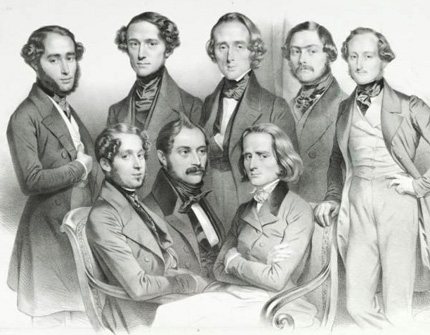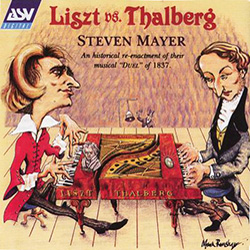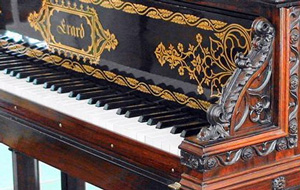The Battle Between “Il penseroso” and “The Old Arpeggio”
Before the time of television and the internet, live music performances were a primary form of entertainment. Performances were held in private homes, as well as concert halls. Many rivalries formed among pianists and composers. This created a unique angle for entertainment as individuals could then debate the merits of each musician and choose sides. One of the more famous piano duels was held between Franz Liszt and Sigismond Thalberg.

J. Rosenhain, T. Döhler, F. Chopin, A. Dreyschock, S. Thalberg, P. E. Wolff, A. von Henselt and F. Liszt
The rivalry first began in 1836 when Liszt had written a critical review of Thalberg’s most recent concert held in Paris. Though the rivalry was a friendly one, a few scathing remarks were made to the press from time to time, most often by Liszt. Meetings of the two were frequent and were always cordial. Liszt even spent time as a guest in Thalberg’s family home near Vienna in the spring of 1838.
 The Gazette musicale announced the program on March 26. “The greatest interest will be without question the simultaneous appearance of two talents whose rivalry at this time agitates the musical world, and is like the indecisive balance between Rome and Carthage.” On the evening of March 31, 1837, Princess Cristina Belgiojoso held a benefit concert for Italian refugees in her Paris salon. Though many musicians performed, the rivalry between Liszt and Thalberg took center stage that evening. So, which pieces were played? Here opinions and sources differ. Some say Liszt began his portion of the concert with his “Grand Gallop Chromatique” and that Thalberg countered with his fantasy variations on Bellini’s “Norma.” Harold C Schonberg mentions Liszt playing his Niobe Fantasia and Thalberg his Moses Fantasia. American pianist Steven Mayer´s re-creation of the duel on the ASV label (1993) suggests the following works.
The Gazette musicale announced the program on March 26. “The greatest interest will be without question the simultaneous appearance of two talents whose rivalry at this time agitates the musical world, and is like the indecisive balance between Rome and Carthage.” On the evening of March 31, 1837, Princess Cristina Belgiojoso held a benefit concert for Italian refugees in her Paris salon. Though many musicians performed, the rivalry between Liszt and Thalberg took center stage that evening. So, which pieces were played? Here opinions and sources differ. Some say Liszt began his portion of the concert with his “Grand Gallop Chromatique” and that Thalberg countered with his fantasy variations on Bellini’s “Norma.” Harold C Schonberg mentions Liszt playing his Niobe Fantasia and Thalberg his Moses Fantasia. American pianist Steven Mayer´s re-creation of the duel on the ASV label (1993) suggests the following works.
Thalberg:
Divertimento on favourite themes by Rossini, Op. 18 “Les Soirées Musica”
Fantasia on “God Save the Queen”, Op. 27
Liszt:
Divertissement sur la cavatine “I tuoi frequenti palpiti” by Pacini, S. 419
Transcription of Konzertstück in F minor by Weber
Harmonies poétiques et réligieuses, S. 173 no 3, Bénédiction de Dieu dans la solitude
Unbeknownst to the other pianist, each one had prepared a new composition to play as their final piece of the night. Liszt’s “Reminiscences de Roberts le Diable” by Meyerbeer is the more well known of the two compositions played that evening. Thalberg’s new piece was “Fantasy” Op. 33, based on Rossini’s “Moise.” The evening was regarded as a draw.
“Never was Liszt more controlled, more thoughtful, more energetic, more passionate; never has Thalberg played with greater verve and tenderness. Each of them prudently stayed within his harmonic domain, but each used every one of his resources. It was an admirable joust. The most profound silence fell over that noble arena. And finally Liszt and Thalberg were both proclaimed victors by this glittering and intelligent assembly… Thus two victors and no vanquished …’ wrote critic Jules Janin in the Journal des Débats although the Princess Belgiojoso´s opinion was: ‘Thalberg is the first pianist in the world – Liszt is unique.”

Erard Grand serial number 13317 purchased in 1834 by Franz Liszt and given to the Princess Belgiojoso as a present.
2012 marks the 200th anniversary of the Austrian Sigismond Thalberg but why is he almost forgotten today? Chopin said of him: “He plays splendidly, but he’s not my man. He’s younger than I and pleases the ladies – makes potpourris on La Muette – produces his piano and forte with the pedal, not the hand – takes tenths as I do octaves and wears diamond shirt studs.” and Clara Schumann: “On Monday Thalberg visited us and played to the delightment beautiful on my piano. An even more accomplished mechanism than his does not exist, and many of his piano effects must ravish the connaiseurs. He does not fail a single note, his passages can be compared to rows of pearls, his octaves are the most beautiful ones I ever heard.”
The way Thalberg played his instrument was probably the exact opposite of Liszt’s approach. The performance of Liszt was all emotions and dramatic movements, a suggestive experience made even more powerful by his blonde mess of hair and the turbulent waving of his hands. Thalberg, on the other hand, was painfully reserved and hardly moved on his chair – while both of them played equally complicated and challenging pieces. Liszt was often called a ’piano-killer’: he could almost destroy instruments of a weaker build with his heavy blows on the keyboard. But Thalberg had his own special skills, too, which Liszt had known nothing about before the crucial concert: his unique way of handling the pedals, and the so-called ’thumbs-effect’ technique, which consisted of, a principal melody in the middle register, played alternately by both thumbs, while both hands are traversing with rapid arpeggios the whole range of the keyboard, producing ever so delicate, crooning tunes from the piano.
Comments
Patrick,
I am bilingual in English and Italian, and “Il penseroso” does not exist in the Italian language. It may be a simple mistype of “Il pensieroso,” which in fact means thoughtful or pensive. I just thought maybe you could make that simple change here. Overall though, it’s quite an interesting article.
Regarding rival composers, I was just reading about two contemporary child prodigies, Clementi and Mozart, and how they even performed together in direct competition. Many people do not realize that Mozart’s famous motive from the overture to finale of “The Magic Flute” was actually borrowed from a well-known Clementi piano sonata in b-flat.
It is always a pleasure reading Piano Street each month, and look forward to next month’s edition.
Kind regards,
Michael
Very interesting read , thank you!
I was wondering which piece was written first, Thalbergs Grand caprice on La sonnambula, Op.46, or Liszts Norma fantasy, there are very similar passages between the 2 with one surely influenced the writing of the other, I would imagine , does anybody know when both were written ?